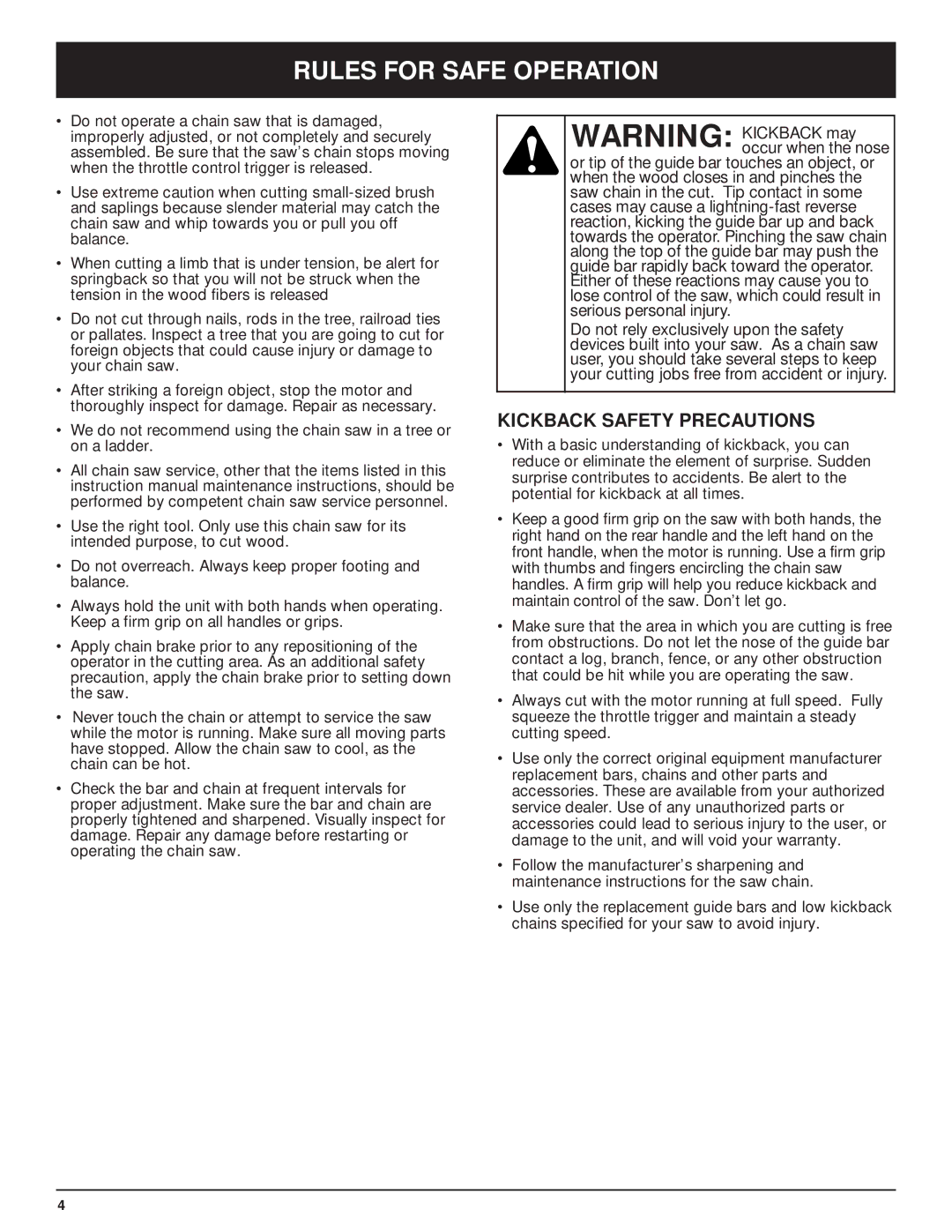
RULES FOR SAFE OPERATION
•Do not operate a chain saw that is damaged, improperly adjusted, or not completely and securely assembled. Be sure that the saw’s chain stops moving when the throttle control trigger is released.
•Use extreme caution when cutting
•When cutting a limb that is under tension, be alert for springback so that you will not be struck when the tension in the wood fibers is released
•Do not cut through nails, rods in the tree, railroad ties or pallates. Inspect a tree that you are going to cut for foreign objects that could cause injury or damage to your chain saw.
•After striking a foreign object, stop the motor and thoroughly inspect for damage. Repair as necessary.
•We do not recommend using the chain saw in a tree or on a ladder.
•All chain saw service, other that the items listed in this instruction manual maintenance instructions, should be performed by competent chain saw service personnel.
•Use the right tool. Only use this chain saw for its intended purpose, to cut wood.
•Do not overreach. Always keep proper footing and balance.
•Always hold the unit with both hands when operating. Keep a firm grip on all handles or grips.
•Apply chain brake prior to any repositioning of the operator in the cutting area. As an additional safety precaution, apply the chain brake prior to setting down the saw.
•Never touch the chain or attempt to service the saw while the motor is running. Make sure all moving parts have stopped. Allow the chain saw to cool, as the chain can be hot.
•Check the bar and chain at frequent intervals for proper adjustment. Make sure the bar and chain are properly tightened and sharpened. Visually inspect for damage. Repair any damage before restarting or operating the chain saw.
WARNING: KICKBACK may occur when the nose
or tip of the guide bar touches an object, or when the wood closes in and pinches the saw chain in the cut. Tip contact in some cases may cause a
Do not rely exclusively upon the safety devices built into your saw. As a chain saw user, you should take several steps to keep your cutting jobs free from accident or injury.
KICKBACK SAFETY PRECAUTIONS
•With a basic understanding of kickback, you can reduce or eliminate the element of surprise. Sudden surprise contributes to accidents. Be alert to the potential for kickback at all times.
•Keep a good firm grip on the saw with both hands, the right hand on the rear handle and the left hand on the front handle, when the motor is running. Use a firm grip with thumbs and fingers encircling the chain saw handles. A firm grip will help you reduce kickback and maintain control of the saw. Don’t let go.
•Make sure that the area in which you are cutting is free from obstructions. Do not let the nose of the guide bar contact a log, branch, fence, or any other obstruction that could be hit while you are operating the saw.
•Always cut with the motor running at full speed. Fully squeeze the throttle trigger and maintain a steady cutting speed.
•Use only the correct original equipment manufacturer replacement bars, chains and other parts and accessories. These are available from your authorized service dealer. Use of any unauthorized parts or accessories could lead to serious injury to the user, or damage to the unit, and will void your warranty.
•Follow the manufacturer’s sharpening and maintenance instructions for the saw chain.
•Use only the replacement guide bars and low kickback chains specified for your saw to avoid injury.
4
